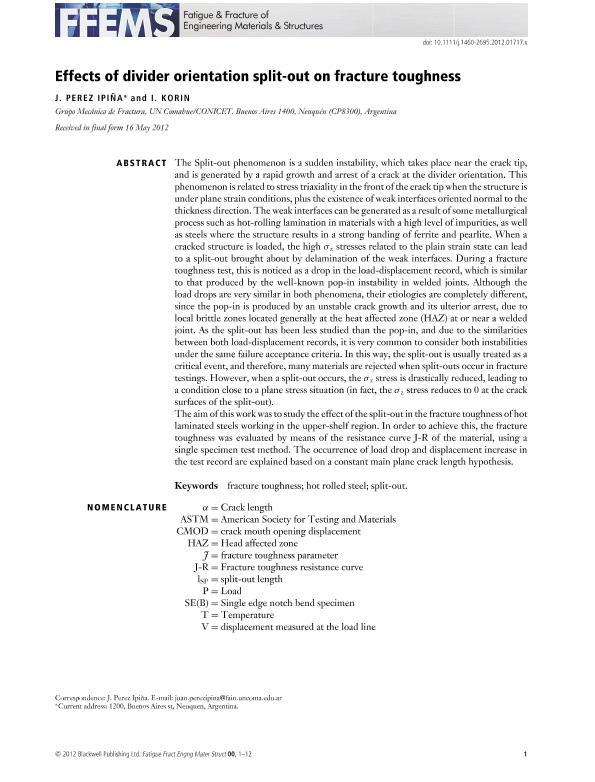Mostrar el registro sencillo del ítem
dc.contributor.author
Perez Ipiña, Juan Elias

dc.contributor.author
Korin, Ivan

dc.date.available
2017-06-07T14:52:33Z
dc.date.issued
2013-03
dc.identifier.citation
Perez Ipiña, Juan Elias; Korin, Ivan; Effects of divider orientation split-out on fracture toughness; Wiley; Fatigue and Fracturee of Engineering Materials and Structures; 36; 3; 3-2013; 242-253
dc.identifier.issn
1460-2695
dc.identifier.uri
http://hdl.handle.net/11336/17659
dc.description.abstract
The Split-out phenomenon is a sudden instability, which takes place near the crack tip, and is generated by a rapid growth and arrest of a crack at the divider orientation. This phenomenon is related to stress triaxiality in the front of the crack tip when the structure is under plane strain conditions, plus the existence of weak interfaces oriented normal to the thickness direction. The weak interfaces can be generated as a result of some metallurgical process such as hot-rolling lamination in materials with a high level of impurities, as well as steels where the structure results in a strong banding of ferrite and pearlite. When a cracked structure is loaded, the high σz stresses related to the plain strain state can lead to a split-out brought about by delamination of the weak interfaces. During a fracture toughness test, this is noticed as a drop in the load-displacement record, which is similar to that produced by the well-known pop-in instability in welded joints. Although the load drops are very similar in both phenomena, their etiologies are completely different, since the pop-in is produced by an unstable crack growth and its ulterior arrest, due to local brittle zones located generally at the heat affected zone (HAZ) at or near a welded joint. As the split-out has been less studied than the pop-in, and due to the similarities between both load-displacement records, it is very common to consider both instabilities under the same failure acceptance criteria. In this way, the split-out is usually treated as a critical event, and therefore, many materials are rejected when split-outs occur in fracture testings. However, when a split-out occurs, the σz stress is drastically reduced, leading to a condition close to a plane stress situation (in fact, the σz stress reduces to 0 at the crack surfaces of the split-out). The aim of this work was to study the effect of the split-out in the fracture toughness of hot laminated steels working in the upper-shelf region. In order to achieve this, the fracture toughness was evaluated by means of the resistance curve J-R of the material, using a single specimen test method. The occurrence of load drop and displacement increase in the test record are explained based on a constant main plane crack length hypothesis.
dc.format
application/pdf
dc.language.iso
eng
dc.publisher
Wiley

dc.rights
info:eu-repo/semantics/openAccess
dc.rights.uri
https://creativecommons.org/licenses/by-nc-sa/2.5/ar/
dc.subject
Fracture Toughness
dc.subject
Hot Rolled Steel
dc.subject
Split-Out
dc.subject.classification
Otras Ingeniería de los Materiales

dc.subject.classification
Ingeniería de los Materiales

dc.subject.classification
INGENIERÍAS Y TECNOLOGÍAS

dc.title
Effects of divider orientation split-out on fracture toughness
dc.type
info:eu-repo/semantics/article
dc.type
info:ar-repo/semantics/artículo
dc.type
info:eu-repo/semantics/publishedVersion
dc.date.updated
2015-10-15T20:01:20Z
dc.journal.volume
36
dc.journal.number
3
dc.journal.pagination
242-253
dc.journal.pais
Estados Unidos

dc.journal.ciudad
Hoboken
dc.description.fil
Fil: Perez Ipiña, Juan Elias. Universidad Nacional del Comahue. Facultad de Ingeniería. Grupo de Mecanica de Fractura; Argentina. Consejo Nacional de Investigaciones Científicas y Técnicas. Centro Científico Tecnológico Conicet - Patagonia Norte; Argentina
dc.description.fil
Fil: Korin, Ivan. Universidad Nacional del Comahue. Facultad de Ingeniería. Grupo de Mecanica de Fractura; Argentina. Consejo Nacional de Investigaciones Científicas y Técnicas. Centro Científico Tecnológico Conicet - Patagonia Norte; Argentina
dc.journal.title
Fatigue and Fracturee of Engineering Materials and Structures
dc.relation.alternativeid
info:eu-repo/semantics/altIdentifier/url/http://onlinelibrary.wiley.com/doi/10.1111/j.1460-2695.2012.01717.x
dc.relation.alternativeid
info:eu-repo/semantics/altIdentifier/doi/http://dx.doi.org/10.1111/j.1460-2695.2012.01717.x
Archivos asociados
